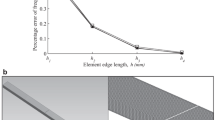Abstract
A novel vibration-based method (VBM) for damage identification, nodal line active modulation (NLAM), is proposed in this study. Unlike traditional VBMs, the NLAM can identify damage by taking advantage of the nodal line effect, which is that when a defect is located on the nodal lines, the dynamic responses of the structure remain nearly unchanged. The basic idea of NLAM is introduced through a simply supported beam. In numerical study, we have discussed the detection steps of the method in detail by detecting a cleft detection in an aluminum plate. In experimental research, piezoelectric transducers work as both actuators and sensors for an added mass damaged detection in carbon fiber reinforced plastic laminates, while a scanning laser Doppler vibrometer is employed for measuring the full-field dynamic response. The damage is visualized from the highlighted nodal lines of the modulated operational deflection shapes. The present investigation provides a new idea for VBM damage detection, which will have practical applications for structural health monitoring.








Similar content being viewed by others
Data Availability
The data and material analyzed during the current study are available from the corresponding author on reasonable request.
References
Doebling, S.W., Farrar, C.R., Prime, M.B., Shevitz, D.W.: Damage identification and health monitoring of structural and mechanical systems from changes in their vibration characteristics: A literature review. Los Alamos Natl. Lab. Rep. (1996). https://doi.org/10.2172/249299
Carden, E.P., Fanning, P.: Vibration based condition monitoring: a review. Struct. Health Monit. 3(4), 355–377 (2004). https://doi.org/10.1177/1475921704047500
Fan, W., Qiao, P.: Vibration-based damage identification methods: a review and comparative study. Struct. Health Monit. 9(1), 83–111 (2011). https://doi.org/10.1177/1475921710365419
Camarena-Martinez, D., Perez-Ramirez, C.A., Valtierra-Rodriguez, M., Amezquita-Sanchez, J.P., Romero-Troncoso, Rd.J.: Synchrosqueezing transform-based methodology for broken rotor bars detection in induction motors. Measurement 90, 519–525 (2016). https://doi.org/10.1016/j.measurement.2016.05.010
An, H., Youn, B.D., Kim, H.S.: A methodology for sensor number and placement optimization for vibration-based damage detection of composite structures under model uncertainty. Compos. Struct. 279, 114863 (2022). https://doi.org/10.1016/j.compstruct.2021.114863
Feng, K., Li, Z.: A novel superposed waveform method for damage detection of composite laminates. Nondestr. Test. Eval. 31(1), 61–76 (2016). https://doi.org/10.1080/10589759.2015.1057586
Pan, J., Shankar, K., Singh, H.K., Wang, H., Zhang, Z., Tong, H.: Vibration-based detection of skin-stiffener debonding on composite stiffened panels using surrogate-assisted algorithms. Compos. Struct. 270, 114090 (2021). https://doi.org/10.1016/j.compstruct.2021.114090
Suryawanshi, V.J., Pawar, A.C., Palekar, S.P., Rade, K.A.: Defect detection of composite honeycomb structure by vibration analysis technique. Mater. Today Proceed. 27(3), 2731–2735 (2020). https://doi.org/10.1016/j.matpr.2019.12.192
Zhang, C., Cheng, L., Qiu, J., Ji, H., Ji, J.: Structural damage detections based on a general vibration model identification approach. Mech. Syst. Signal Process. 123, 316–332 (2019). https://doi.org/10.1016/j.ymssp.2019.01.020
Lu, L., Song, H., Yuan, W., Huang, C.: Baseline-free damage identification of metallic sandwich panels with truss core based on vibration characteristics. Struct. Health Monit. 16(1), 24–38 (2017). https://doi.org/10.1177/1475921716660055
Li, B., Li, Z., Zhou, J., Ye, L., Li, E.: Damage localization in composite lattice truss core sandwich structures based on vibration characteristics. Compos. Struct. 126, 34–51 (2015). https://doi.org/10.1016/j.compstruct.2015.02.046
Wang S, Fong RY, Yuan FG (2021) Vibration-based Damage Imaging via High-speed Cameras with 3D Digital Image Correlation using Wavelet Transform.SPIE Conference Proceeding Doi: https://doi.org/10.1117/12.2585246.
Solodov, I., Bai, J., Begulyan, S., Busse, G.: A local defect resonance to enhance acoustic wave-defect interaction in ultrasonic nondestructive evaluation. Appl. Phys. Lett. (2011). https://doi.org/10.1063/1.3663872
Solodov, I.: Resonant acoustic nonlinearity of defects for highly-efficient nonlinear NDE. J. Nondestr. Eval. 33(2), 252–262 (2014). https://doi.org/10.1007/s10921-014-0229-9
Feng, K., Zhao, Q., Li, Z.: Baseline-free damage identification method for lattice sandwich structures based on operational deflection shapes. Res. Nondestr. Eval. 32(3–4), 147–159 (2021). https://doi.org/10.1080/09349847.2021.1946224
Flynn, E.B., Jarmer, G.J., Chong, S.Y.: Structural imaging through local wavenumber estimation of guided waves. NDT and E Int. 59, 1–10 (2013). https://doi.org/10.1016/j.ndteint.2013.04.003
Jeon, J.Y., Kim, D., Park, G., Flynn, E., Kang, T., Han, S.: 2D-wavelet wavenumber filtering for structural damage detection using full steady-state wavefield laser scanning. NDT E International 116, 102343 (2020). https://doi.org/10.1016/j.ndteint.2020.102343
Jeon, J.Y., Gang, S., Park, G., Flynn, E., Kang, T., Han, S.W.: Damage detection on composite structures with standing wave excitation and wavenumber analysis. Adv. Compos. Mater 26(S1), 53–65 (2019). https://doi.org/10.1080/09243046.2017.1313577
Acknowledgements
This research is supported by the National Natural Science Foundation of China (Grant No: 11702118, 12102092 and 12232001)
Funding
This research is supported by the National Natural Science Foundation of China, (Grant Nos: 11702118, 12102092, 12232001)
Author information
Authors and Affiliations
Contributions
All authors contributed to the study conception and design. Kan Feng proposed and fulfilled the method and wrote the main manuscript. Rong Li, Jing Yan and Xu Hu helped with the experiment and the numerical analysis. Jie Zhou and Zheng Li provided constructive opinions on the method and revised the manuscript. All authors read and approved the final manuscript.
Corresponding author
Ethics declarations
Competing Interests
All authors certify that they have no affiliations with or involvement in any organization or entity with any financial interest or non-financial interest in the subject matter or materials discussed in this manuscript.
Ethical Approval
Not applicable.
Consent to Participate
Not applicable.
Consent for Publication
All authors gave their consent for publication.
Additional information
Publisher's Note
Springer Nature remains neutral with regard to jurisdictional claims in published maps and institutional affiliations.
Rights and permissions
Springer Nature or its licensor (e.g. a society or other partner) holds exclusive rights to this article under a publishing agreement with the author(s) or other rightsholder(s); author self-archiving of the accepted manuscript version of this article is solely governed by the terms of such publishing agreement and applicable law.
About this article
Cite this article
Feng, K., Li, R., Yan, J. et al. Damage Identification Based on the Nodal Line Active Modulation Method. J Nondestruct Eval 42, 70 (2023). https://doi.org/10.1007/s10921-023-00979-1
Received:
Accepted:
Published:
DOI: https://doi.org/10.1007/s10921-023-00979-1




